Fifth Avenue and 103rd Street
The Museum of the City of New York was built in 1931. John D. Rockefeller, Jr. was one of the small group of major contributors.
The Museum has a very important facet which does not seem to have received the attention it deserves. That is its display of New York City interiors. There is one floor where there are rooms ranging from the Greek Revival to the 1900s, and they are unique among their kind. Of equal importance, and in a way more distinctive because their equal is not to be found elsewhere, are two rooms from John D. Rockefeller's house that once stood at 4 West 54th Street, a site now occupied by a wing of the Museum of Modern Art. One room was also installed in the Brooklyn Museum.
The house was built in 1882 by Mrs. Arabella Worsham who became the wife of Collis P. Huntington, one of the Big Four of California, along with Leland Stanford, Mark Hopkins, and Charles Crocker. Huntington is so closely connected with the development of the Bear State that it is often forgotten that he lived much of his life in New York. His house, 4 West 54th Street, was large, in standard brownstone and Philadelphia pressed brick. The style was Anglo-Italian or Italianate which stemmed from Italian-influenced buildings constructed in London in the 1840s. The interior, as we know from the rooms, was very elaborate. While the lavish ornament is not easy for us to understand or to accept, we cannot help but admire the skill of the craftsmen, woodworkers, furniture makers, wood-inlay workers, and others. The firm which executed it, George A. Schastey & Company, was probably of German origin, but it would have employed not only Germans but Frenchmen, and possibly English artisans as well. We forget that while the city was not the most important furniture manufacturing center, it was nevertheless the place where the best was made. Nor should we be surprised at this because it was, first of all, a center of wealth and, second, it was where the immigrant craftsmen landed.
The influence was, to say the least, eclectic. The furniture of the bedroom, known as "art furniture," was in the Eastlake Style. The room had a Turkish corner. Colored glass is abundant. The dressing room is equally opulent. Here the woodwork is rosewood with inlay of mother-of-pearl. Tufted chairs, fringed curtains, lace curtains, sconces and chandeliers in silver and gilt, stained glass, figured wallpaper form an altogether staggering display.
The tour continues down Fifth Avenue to turn into Central Park just south of 80th Street. The purpose of this diversion is to see the Michael Rockefeller Wing built to house the Department of the Arts of Africa, Oceania, and the Americas; it was given to the Metropolitan Museum of Art by Nelson Rockefeller as a memorial to his son who died on an expedition in the South Pacific.
The tour continues down Fifth Avenue to 70th Street to go over to Park Avenue. It stops at the northeast corner of Park and 70th where the Asia Society has its building.
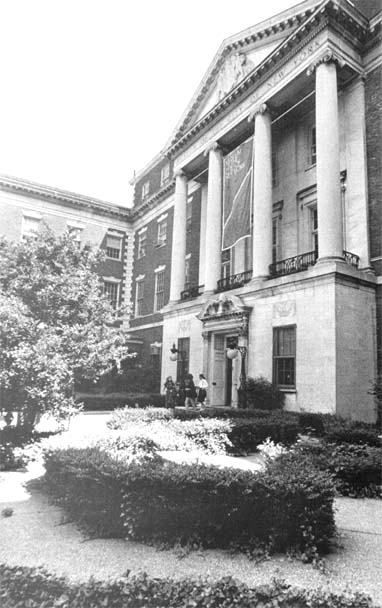 |
| Museum of the City of New York. |
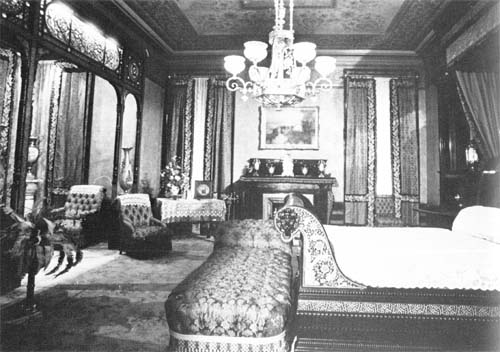 |
| The master bedroom from the Rockefeller residence, the City of New York. |
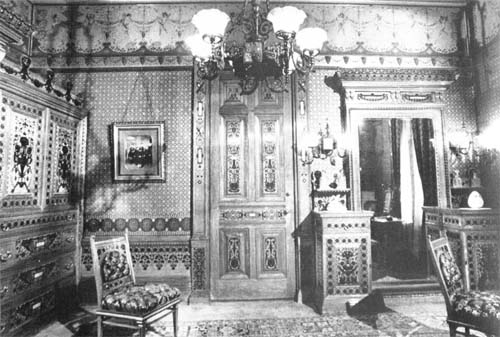 |
| A dressing room from the Rockefeller residence, Museum of the City of New York. |
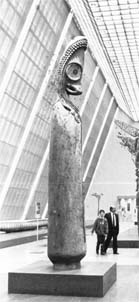 | | 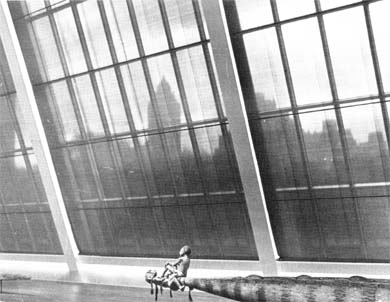 |
| Left: A slit-gong, ceremonial musical instrument of the New Hebrides, in the Michael Rockefeller Wing, Metropolitan Museum of Art. Below: Canoe of the Asmat Tribe, from New Guinea. Looking southeast through the glass wall of the Michael Rockefeller Wing. |







